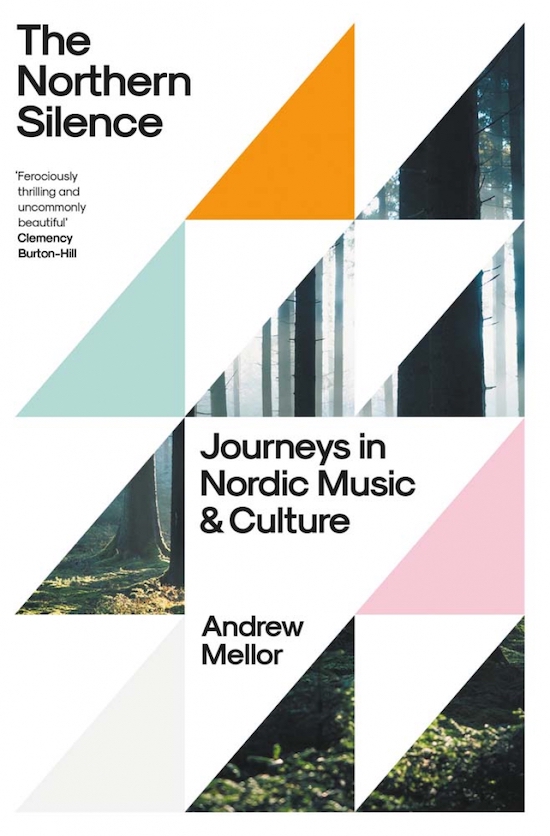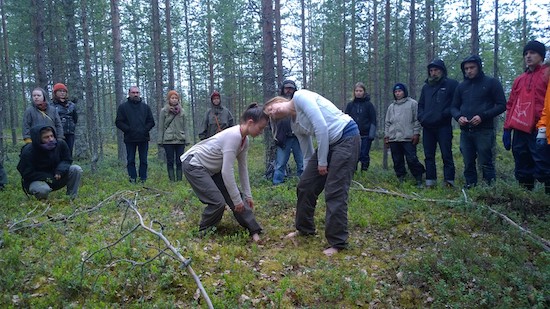Photo credit: Andrew Mellow
Kaukonen was described as a village but I searched in vain for a shop, a café or even a wall that could support a cash dispenser. Its central feature was a confection of rusting tractors, lined-up on a verge next to the gravel road that tracks the River Ounasjoki. I arrived here one afternoon in June 2016, reporting for duty as a volunteer at a homespun arts festival after a 100-minute drive north from the capital of Finnish Lapland, Rovaniemi. “At Silence Festival you will experience art, beautiful nature and a very special atmosphere,” promised the website.
Silence Festival has no need of visiting journalists, which is why I had to sneak in under the guise of a volunteer. On the first morning, I was tasked by the festival administrator Ninni with helping to move two industrial refrigerators from a lorry into a side-room of Kaukonen’s Village Hall, which would function as the festival bar. With two bulky Finns for assistance, I was supervised by the bar manager Heidi, who rolled cigarettes on a fence post as she directed us. After offering me coffee from her flask, she poured her own into the small hollowed-out chunk of wood that hung permanently from a loop on her cargo pants.
Later that day I was sent out into the village with a pile of laminated posters and a staple-gun. I learned the lie of the land and the deep river that cuts through it. Its banks were lined with verdant sloping meadows and stony wastelands. At the end of a track, the stump of an old wooden bridge gestured at its amputated partner on the opposite side of the water; a new, concrete bridge had long since been built a few kilometres upstream, signaling the death knell for this one. At Silence Festival’s headline show some days later, the acrobat Sanja Kosonen would cross the river here on a tightrope while the musician Marzi Nyman stood on the opposite bank, in a red pin-striped suit, playing psychedelic loops on an electric guitar while villagers and festivalgoers looked on.
Kaukonen, with its huddles of three or four ramshackle wooden buildings, felt like an inhabited wilderness. There were copious parallels with the American Midwest but they took human form in the festival security officer, Snuupi. An early retiree from Finland’s special forces – or so everyone said – he stalked about Kaukonen all week as if on the trail of a dangerous animal, all manner of tackle and weaponry hanging off him. He wore a rock-like expression on his face, which shifted as little as the intonation in his voice. I’ve not encountered another human being whose very presence was at once so reassuring and so unsettling.
For the first three days of Silence Festival, Storm Solomon lashed Kaukonen with unceasing wind and rain. That didn’t stop Snuupi rowing me out to the middle of the river’s widest point, where I clambered onto a small floating platform accommodating a wood-fired sauna the size of a small garden shed. I stripped and went inside, where a freelance philosopher was waiting, under orders to discuss whatever was on my mind. We talked about silence and music, and about the emotional duress of organized religion, heading outside to swim in the cold river now and then before stepping back into a heat so fierce it roasted the back of your throat at the first breath. After an hour, Snuupi reappeared in his kayak to take me back to shore.
I was bivouacked in a ramshackle cabin about a kilometre from the village hall, which had its own wood-fired sauna. The surrounding birch trees held the little structure in their silent embrace. After days of persistent rain, the air and ground started to dry and the skies lightened. At this latitude there was no real darkness at night, but the dank weather ensured there was also no direct sunlight for much the festival either. In the early hours on my last night in Kaukonen, deep into the festival’s closing party, a woman burst into the throbbing village hall with the announcement that the clouds were parting. A dozen or so survivors of the festivities rushed onto the veranda to see the sun pour itself out onto sloping meadows and unpainted wooden barns. Newborn, unfettered sunlight at 3 a.m. – the purest form of inland light there is.
There was no artistic normal at Silence Festival. I heard bandoneón music from Argentina played straight in a wooden church, a useful reminder that the country’s biggest musical export, tango, was received more wholeheartedly in Finland than anywhere else (though the Finns insist on transposing their tangoes into minor keys). An emotionally strenuous choreographic piece saw two dancers wrenched apart from one another while two musicians protested in the corner to tunes by Toivo Kuula and Einojuhani Rautavaara –Sibelius’s contemporary and protégé respectively. At an art gallery in a neighbouring village, there was a performance of Stravinsky’s A Soldier’s Tale. I was joined for some meals and drinks by the festival’s co-artistic director Outi Tarkiainen, a Rovaniemi-born, London-trained composer whose own piece Kunnes kivi halkeaa (‘Until the Stone Splits’) was played one lunchtime by the violinist Minna Pensola. It is a monologue for violin that obsesses over two adjacent notes. Over the course of six minutes those notes are prized apart by an overwhelming grief.

Silence Festival was less about its individual events and more about our collective journey through them as performers, staff, audience and villagers – the latter two groups amorphous. One afternoon, we were led through a forest by the dancers Sade Kamppila and Viivi Roiha, who gradually shed their clothes as they told emotionally humid stories of animals and men. When we thought the performance of their dance piece Metsä had ended – the two girls having capered away nude, hand in hand – we trudged towards home before hearing the sound of faraway singing. Off in the distance, Kamppila and Roiha were sitting on a cliff edge overlooking a quarry, waving us farewell as they tended a fledgling fire.
The festival felt most real during the variety performances at the village hall, which ranged from poetry readings to a covers band, with equally strong emphases on contemporary music and circus arts. Watching them cross-legged on the floor was like being sucked into the parallel reality of an Aki Kaurismaki film. This was an analogue domain that refused to indulge the metropolitan or the digital but had room for the occasional twenty minutes of blazing avant-garde. Every performance was received by the audience with a sort of deadpan acceptance, except by the drunks who heckled or roared with laughter.
That audience included an elderly man, motionless in a wheelchair, his delight expressed through wide eyes and twitching feet. A Finnish-Japanese teenager from Helsinki had made the journey from her parents’ new home a few kilometres away, intrigued by what might be going on here having seen a listing on Facebook, bored stiff by her summer holiday. There was a group of 30-something lads, baggage handlers from the nearby Kittila Airport, who had heard that for one week only Kaukonen would have its own licensed bar. That is where they cornered me one night, full of conspiracy theories about unmarked Russian aircraft on the airport’s apron. At the same bar stood Tarkiainen’s erstwhile composition professor, having made the journey north to support his former pupil.
Marzi Nyman’s performances lingered long after I had reentered the real world back in Helsinki, wondering if Silence Festival had been for real. He popped up on so many occasions during the week, always able to pull whatever musical discourse he found himself embroiled in up to another level, no matter what instruments he had or didn’t have at his disposal. His own performances ranged from atonal free improvisation to David Bowie covers with the rough-cut Kaukonen Village Band.
On the festival’s opening night, Nyman’s own trio played at Villa Magia, the little hut that is Kaukonen’s spiritual home, while Storm Solomon played a cat-and-mouse game with the electricity supply. The moments when the power cut out were the best, as Nyman and his co-conspirators simply made music as it came to them with whatever was lying around – literally unplugged. On a drier, calmer day later in the week, he stood in a huge forest clearing and belted out riffs on his guitar like a rock star warming-up in an empty stadium built of trees. Wailing through an amplifier, his stilted tunes started to resemble yoiks, the traditional, existential songs of the Sámi, Lapland’s indigenous people.
The Northern Silence: Journeys in Nordic Music and Culture by Andrew Mellor is published by Yale University Press



